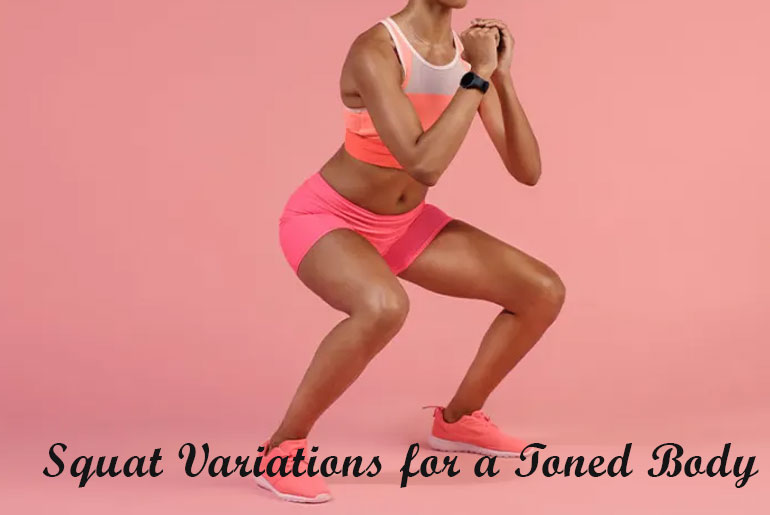There’s a reason squats are a classic: they are a highly efficient exercise that targets multiple muscle groups simultaneously, including the quads, hamstrings, glutes, and core. This makes squats one of the most effective moves for building strength, improving flexibility, and enhancing overall fitness. They help increase muscle tone, boost metabolism, and support joint health. Additionally, squat variations improve balance and coordination, making them beneficial for daily functional movements. Whether performed with body weight or added resistance, squats are a simple yet powerful exercise that delivers comprehensive physical benefits.
Squat variations are effective for achieving a toned and sculpted body, targeting various muscle groups and providing a comprehensive lower-body workout. Here’s a detailed breakdown of five popular squat variations:
Squat to Lunge:
This dynamic move combines a squat with a forward lunge, targeting the quadriceps, hamstrings, and glutes. By alternating between the squat and lunge, it helps build lower-body strength, flexibility, and balance. It also engages the core for stability, making it an effective way to tone the legs and improve overall coordination.
How to:
- Start by standing with feet shoulder-width apart.
- Lower into a squat position, keeping your knees behind your toes and your chest lifted.
- Push through your heels to stand back up and immediately step one foot forward into a lunge position.
- Lower your back knee towards the ground, ensuring your front knee stays aligned with your ankle.
- Push off the front foot to return to standing and repeat the movement on the other leg.
Perform 10–12 reps per leg for each set.
Sumo Squat:
With a wider stance and toes turned outward, the sumo squat primarily targets the inner thighs, glutes, and quadriceps. This variation helps shape the legs and hips, increasing muscle definition in the lower body. It also challenges the stabilizing muscles, making it an excellent move for toning and shaping the legs.
How to:
- Stand with your feet wider than shoulder-width apart, with toes pointed outward at a 45-degree angle.
- Lower your body into a squat, ensuring your knees are tracking over your toes and your chest stays upright.
- Go as low as your flexibility allows, ideally until your thighs are parallel to the ground.
Push through your heels to return to standing.
- Perform 12–15 reps for each set.
Bulgarian Split Squat:
Performed with one foot elevated behind you on a bench or step, this squat variation focuses on one leg at a time, targeting the glutes, hamstrings, and quads. It helps improve balance and stability while shaping the legs and glutes. This move is particularly effective for isolating muscle groups and enhancing lower-body strength and tone.
How to:
- Stand a few feet in front of a bench or elevated surface and place one foot on it, ensuring your back knee is slightly bent.
- Lower your hips straight down by bending your front knee, keeping your back leg elevated and your torso upright.
- Lower until your front thigh is parallel to the ground, ensuring your knee does not pass your toes.
- Push through the heel of the front foot to return to standing.
- Perform 10–12 reps per leg for each set.
Wall Squat:
This simple yet effective isometric exercise involves squatting against a wall and holding the position for an extended period. It primarily targets the quadriceps and glutes while also strengthening the core. The wall squat helps build endurance and muscle definition in the lower body without requiring additional equipment.
How to:
- Stand with your back against a wall, feet about shoulder-width apart, and a little away from the wall.
- Slide your back down the wall as you bend your knees, lowering your body into a squat position.
- Keep your knees at a 90-degree angle and your back flat against the wall.
- Hold the position for 30-60 seconds, focusing on engaging your core and quads.
Perform 2–3 sets.
Reach Squat:
This variation combines a traditional squat with an overhead reach, engaging both the lower body and upper body simultaneously. By reaching upward while maintaining proper squat form, it targets the quadriceps, hamstrings, glutes, and core, while also increasing flexibility and balance. This move is great for improving body coordination and toning the entire body.
How to:
- Start by standing with your feet shoulder-width apart.
- Lower your body into a squat, keeping your knees behind your toes and your chest upright.
- As you squat down, extend your arms overhead, keeping them straight and aligned with your body.
- Stand back up while bringing your arms back down to your sides.
- Repeat for 12–15 reps per set.
Incorporating these squat variations into your workout routine can help achieve a well-toned physique. Each variation focuses on different muscle groups, making your workouts more versatile and effective for shaping and strengthening the body.
Benefits of doing squats:
Squats are one of the most effective and versatile exercises for overall fitness, offering numerous benefits for the body. Here are the key benefits of incorporating squats into your routine:
1. Tones and Strengthens Lower Body: Squats primarily target the quadriceps, hamstrings, glutes, and calves. Regularly doing squats helps tone and strengthen these muscles, leading to a more sculpted and powerful lower body.
2. Improves Core Strength: Squats engage the core muscles, including the abdominals and lower back, to maintain balance and stability. This strengthens the core, improving posture and reducing the risk of back pain.
3. Boosts Metabolism: Squats are a compound exercise that engages multiple large muscle groups, increasing calorie burn. This helps boost metabolism and promotes fat loss, contributing to overall body fat reduction.
4. Enhances Flexibility and Mobility: Squats, particularly when performed with a full range of motion, improve joint flexibility and mobility in the hips, knees, and ankles. This can prevent stiffness and enhance overall movement quality.
5. Improves Balance and Coordination: Squats require balance and coordination, especially when variations such as single-leg squats or jump squats are performed. This helps improve functional fitness and stability in daily activities.
6. Increases Bone Density: Weight-bearing exercises like squats help increase bone density, reducing the risk of osteoporosis and promoting overall bone health. This is particularly important as we age.
7. Supports Joint Health: By strengthening the muscles around the knees, hips, and ankles, squats help support and stabilize the joints, reducing the risk of injuries and promoting long-term joint health.
8. Boosts Athletic Performance: Squats improve power, speed, and explosiveness, making them a key exercise for athletes. Strengthening the lower body through squats enhances performance in sports and other physical activities.
9. Increases Functional Strength: Squats mimic natural movements like sitting, standing, and lifting, which translates to functional strength. The ability to squat with proper form can make everyday tasks easier and safer.
10. Promotes Cardiovascular Health: While primarily a strength-building exercise, squats also elevate the heart rate, particularly when performed in higher repetitions or as part of a high-intensity workout. This can improve cardiovascular health and endurance.
Incorporating squat variations into your fitness routine offers a range of physical benefits, making it a fundamental exercise for building strength, improving overall health, and enhancing functional fitness.
Disclaimer:
The information contained in this article is for educational and informational purposes only and is not intended as a health advice. We would ask you to consult a qualified professional or medical expert to gain additional knowledge before you choose to consume any product or perform any exercise.








